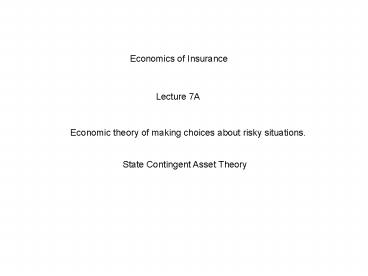Economic theory of making choices about risky situations' - PowerPoint PPT Presentation
1 / 10
Title:
Economic theory of making choices about risky situations'
Description:
State 2 (burgled) assets worth 5856 (some assets locked in safe so can't be taken by burglar) ... large enough to restrict the burglar to 2000 worth of goods. ... – PowerPoint PPT presentation
Number of Views:31
Avg rating:3.0/5.0
Title: Economic theory of making choices about risky situations'
1
Economics of Insurance
Lecture 7A
Economic theory of making choices about risky
situations.
State Contingent Asset Theory
2
State contingent asset diagram 1
X2
State Contingent Asset Space
X1 is value of assets in state 1
X2 is value of assets in state 1
Suppose your assets were just the CONTENTS of
your rented (ie no asset value) house
State contingent asset value
5000
e.g. TV set computer jewellery
X1
10000
If your house is not burgled
your assets are worth 10000
(state of the world 1)
(state of the world 2)
and some of the contents stolen,
If your house is burgled
your assets are worth only 5000
State contingent asset value
(10000, 5000)
3
State contingent asset diagram 2
Suppose a safe was hired for 1000
State 1 (no burglary) assets worth 10000 -1000
9000
State 2 (burgled) assets worth 5856 (some assets
locked in safe so cant be taken by burglar).
4
Choosing to hire a safe State contingent
indifference curves
Option 1Hire safe and have less money if no
burglary but more money than otherwise if
burglary
?safe (9000, 5856 0.6, 0.4)
Option 2Not hire safe and have less money than
otherwise if burglary but more money if no
burglary
? no safe (10000, 5000 0.6, 0.4)
We choose on the basis of E(U)
If E(U) log X
P2 0.4
P1 0.6
E(U) safe 0.6 log9000 0.4log
5856 3.8796
E(U) no safe 0.6 log10000 0.4log 5000
3.8796
Rents safe
Does NOT rent
safe
5
Set of SCICs
Supposing our safe was large enough to restrict
the burglar to 2000 worth of goods. Our prospect
would now be
? large safe (9000, 7000 0.6, 0.4) with E(U)
.6log9000.4log7000 3.9105
Utility higher than either previous prospect so
point would be to the right of the original
indifference curve
6
Certainty line
A 45 degree line through the origin of the
diagram has the property that X1 X2
SO, WHATEVER THE EVENT, THE MONEY OUTCOME WOULD
BE THE SAME IF THE PROSPECT LIES ON ANY PART OF
THIS LINE.
7
Properties of SCICs
X2
Downward sloping
X1
X2
U3
U2
U1
More utility than U2
More utility than U1
X1
8
X2
Additional properties of SCICS
SLOPE -P1 x Marginal Utility X1
P2 Marginal Utility X2
a,b
Slope at point (a,b)
- odds x marginal rate of substitution
determined by attitude towards risk
given
X1
9
Property 3Transitive and Convex to origin
An individual with a given attitude to risk (i.e.
stable utility wrt money function) faced with
options with identical probabilities of events
will show consistent (transitive) preferences
i.e. INDIFFERENCE CURVES DO NOT CROSS EACH OTHER
Wrong!
X2
CONVEXITY with respect to thte origin comes from
the ASSUMPTION of risk aversion (see next lecture)
Bent inwards towards the origin
X1
10
SCICs swivel down as odds of bad event increase
(no change in attitude to risk)
X2
Certainty line X1 X2
SCIC small prob bad event
SCIC mediuml prob bad event
SCIC large prob bad event
Slope of SCIC as it crosses the certainty line is
equal to the odds against the bad event (event 2)
Steep slope on certainty line
Less steep slope on certainty line
Least steep slope on certainty line
Initial prospect
X1
Odds dotted line slope, which is less than
previous dotted line slope, so odds AGAINST BAD
EVENT lower, i.e. BAD EVENT MORE LIKELY TO HAPPEN
Odds dotted line slope which has again
declined, so odds AGAINST BAD EVENT even lower,
i.e. BAD EVENT EVEN MORE LIKELY TO HAPPEN































